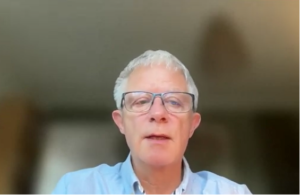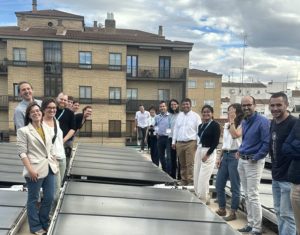Great Britain: Waterless Radiators work well with optimised Vacuum Tubes
June 7, 2010
This house in the town of Wimborne Minster in South West England is heated by a glycol-free solar thermal installation. The new system is designed to channel solar-heated water directly to specially designed waterless radiators, bypassing the thermal storage tank.
Photo: Jayhawk International Ltd
The developer of this unique solar heating system, Eric Hawkins, is also the owner of the house on which it was set up. The Technical Director of the British company Jayhawk International Ltd has spent 18 years researching and developing solar hot water systems. Jayhawk offers a wide range of energy-saving technologies for residential and commercial clients.
The major innovation incorporated into Hawkins new solar heating system relates to the radiators with integrated heat pipes. “The schematic looks like a heat pipe vacuum tube collector turned upside-down – without the tubes,” Hawkins explains. The solar-heated water flows through the copper pipe manifold of each radiator located at the bottom. The flow of 50 to 60°C hot water evaporates the alcoehol/water mix in the sealed copper pipes at the radiators, which does so at low temperatures of only 35 to 40°C. The two copper risers with 20 mm are incorporated within an aluminium fin which radiates the heat into the room.
“In the future, I can run the heating system in my 3-bedroom house with only 15 litres in the complete circuit compared to the 115 litres today. This is only 10% of what a conventional system with water-filled steal radiators would need,” Hawkins explains one of the major advantages of the new radiators. And, it results in a fast heat transfer time. Hawkins recommends using an insulated and helical stainless steel pipe to connect the radiators to each other. The new type of radiator also includes a room thermostat in its standard version, but with no need for an air vent.
The second important innovation lies in the design of the heat exchanger incorporated into the solar collector manifold. Hawkins re-designed the copper heat exchanger, increasing the diameter of the copper tube to 35mm, in order to eliminate the need for glycol as freeze protection. “I kept increasing the diameter of the pipes before I found that water would not split the copper pipes even at night time in the depth of winter,” Hawkins explains. His changes resulted in a greater water volume of 1.5 litres per 30 tubes, compared to an Apricus 30-tube collector with 0.75 litres for the same number of square metres.
After coming into operation, the heat pipe collectors and the heat pipe radiators have since worked together perfectly. The heated water from the solar collectors can be fed directly to the heating circuit by passing through a motorised zone valve. If there is no demand for warming up the house during daytime, the solar energy can be stored in the 250- to 300-litre buffer tank, which offers the alternative of heating the water with a gas/electric fusion boiler. Hawkins expects to reduce his overall heating and hot water demand by some 20,000 kWh/year.
More information:
http://www.jayhawk-int.com


